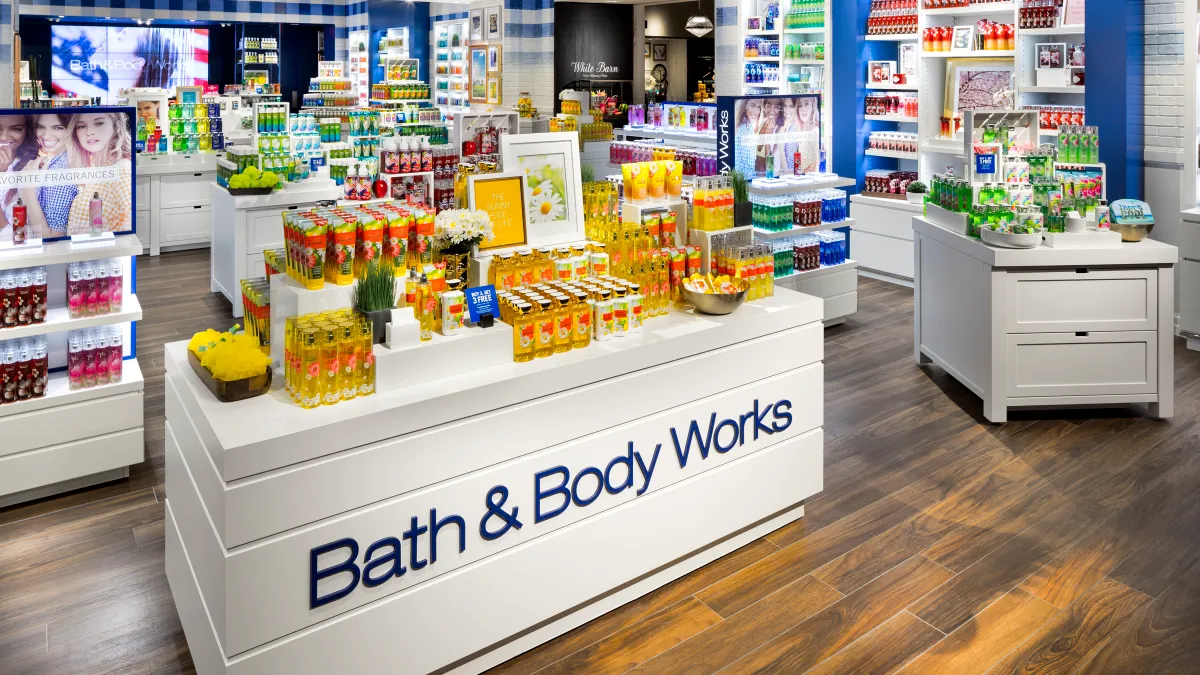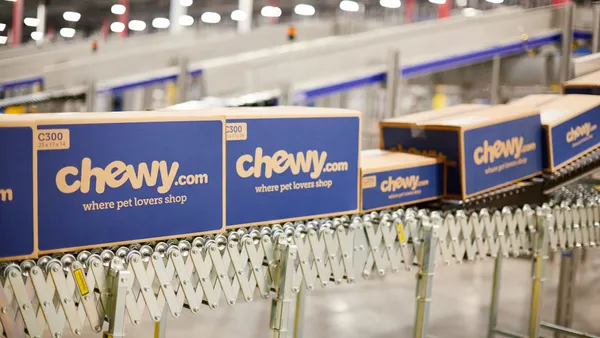L Brands investors breathed a sigh of relief this week thanks to what Instinet's Simeon Siegel called "better-than-feared results" for the first quarter, echoing a common sentiment among analyst notes emailed to Retail Dive.
In the quarter ended May 4, the company's net sales edged up to $2.629 billion from $2.626 billion a year ago, according to its press release. While the 5% comp decline at Victoria's Secret was better than expected, that metric carried a now familiar quarterly theme: The retail company's overall flat comps owed a lot to the 13% comp surge at its personal care brand, Bath & Body Works.
"[W]e received some much needed good news (or at least less bad) from [L Brands] this afternoon, as the company showed some level of stability at VS ..., and once again posted meaningful upside via the Bath & Body business," Wells Fargo Senior Analyst Ike Boruchow wrote in a client note emailed to Retail Dive. "[T]he strength of this business is among the brightest spots in retail today."
But, while praise is often heaped on Bath & Body Works, its success isn't usually unpacked the way Victoria's Secret's failures are.
Victoria's Secret still provides the bulk of the revenue — its contribution to net sales in the quarter was $1.5 billion compared to Bath & Body Works' $870 million. But their diverging trajectories have become painfully evident, to the point where activist investor Barington Capital Group in March suggested a possible spinoff of the personal care brand, complaining that the flagship was undermining its value to investors. (That led to the nomination of two new independent directors to L Brands' board and the appointment of Barington as "special advisor.")
In his original letter to L Brands CEO Les Wexner, Barington chief James Mitarotonda said "the performance of Bath & Body Works has been exceptional," noting that its operating income grew from $858 million in fiscal 2015 to $1.08 billion in fiscal 2018, with EBITDA margins of some 25% and strong same store sales growth.
L Brands CFO Stuart Burgdoerfer this week told analysts that the brand is "firing on all cylinders ... in terms of the home fragrance business, the hand soap business and the body care business."
"[T]hey don’t bat a 1000%, they don’t get it right every time," he said regarding the Bath & Body Works team, according to a transcript from Seeking Alpha. "But their major books of business are performing well and where they've introduced compelling new fashion and newness in their key items, key categories they've gotten a strong consumer response. So that's got them excited and they leverage [a] very fast supply chain to manage the risk of that. They do a good job of it."
That success is not just good management, however. What none of those "key categories" includes is apparel, and that is a major advantage in retail today, according to Lee Peterson, executive vice president of thought leadership and marketing at WD Partners, who noted that Wexner himself in recent decades unloaded many of the apparel banners he founded, including The Limited, Express and Lane Bryant as the apparel market lost sales. Plus, according to Instinet, the brand has almost no exposure to newly expanded China tariffs.
"Apparel is more difficult than ever," Peterson told Retail Dive in an interview, adding that Bath & Body Works also employs some of Wexner's best retail principles, to its advantage. "It’s more that it’s not apparel, but it is also execution — they've got things down to a science. Really great planograms and product extensions. Constant testing. Those things really work and have been in place for 40 years. But when it’s just bottles of stuff and not clothes, it's not as complicated. It's also the kind of thing you’ve got to smell it to check it out, so you’re less threatened by it online."
Bath & Body Works also has an advantage running a more rational store fleet in better-performing locations, while Victoria's Secret is grappling with an over-extended one, much of it in lesser malls, according to a March Cowen & Co. report emailed to Retail Dive. In the quarter the company announced this week, physical store comps at Victoria's Secret fell 7% after falling 5% in the year-ago period, while at Bath & Body Works brick-and-mortar comps did just the opposite, rising 7% after last year's 5% increase. The results dragged total store comps down 3% in the quarter.
Not including franchises, Victoria's Secret runs 957 stores and its Pink brand runs 141 in the U.S., while Bath & Body Works runs 1,619. In February, L Brands announced plans to shutter 53 Victoria's Secret stores, or 4% of its fleet, after closing 30 last year, to help right-size those operations. Calling Victoria's Secret's footprint "unwieldy," Cowen analysts maintained that closing 15% to 20% of Victoria's Secret's fleet, or about 150 stores, could improve profitability in remaining stores.
Victoria’s Secret, which has been slow to respond to evolving consumer taste in lingerie and tolerance of its marketing, has also suffered a loss of market share in the segment. Investors this week signaled patience with newly arrived brand chief John Mehas, who has already taken steps to "remix the assortment" and is "making substantial change," Burgdoerfer told analysts.
Meanwhile, Bath & Body Works can carry on without the worries of a turnaround. In another report from this week, Cowen analysts led by Oliver Chen suggested that its superior performance has legs. "We have wondered if excess promotions drove [the brand’s] 11% FY18 comp," Chen wrote, but said its first quarter comp, conversion, price and margin increases belie that notion. He also noted that its average comp over the past decade stands at 5%. "These are signs of healthy growth and make us believe [Bath & Body Works] will continue to comp positively."















